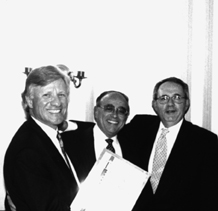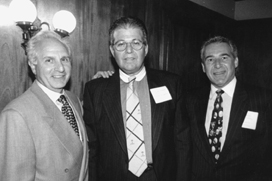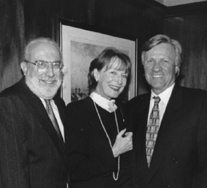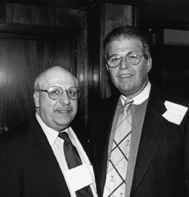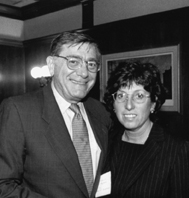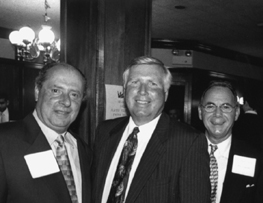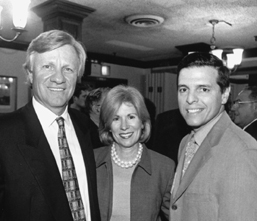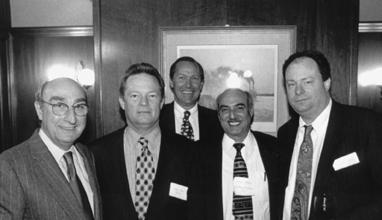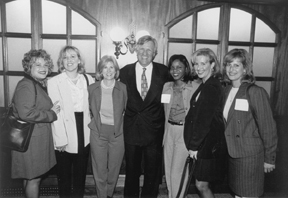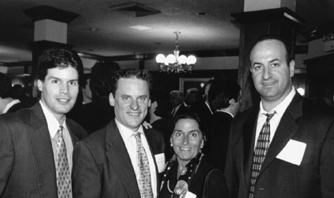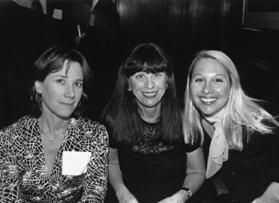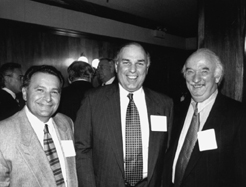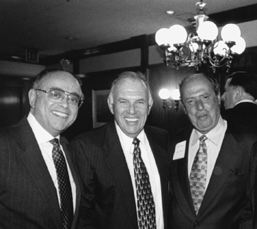Aldo Parcesepe Sr. Managing Director OTC Trading Bear Stearns & Co.
Wider spreads? That's a possibility. I think that the forces of supply and demand will dictate whether [the minimum trading increment] will be rounded up or down. [Regulators] are making one assumption that it's going to be rounded down. It might very well be rounded down, but the costs that drive the marketplace are going to drive the rounding, not the fact that they pass a rule saying that [the minimum increment] must be a decimal. If people can't make money at narrower spreads then the spreads will widen.
I think the regulators would like for us to do business at a penny a share. The reality may be something different. As you decrease the commission base you get to a point where you can no longer make the overhead. At this point people will start walking away because they cannot support their business.
Ideally it might be nice to do business at a penny a share, but what kind of service would you get at a penny a share? You'd be getting service worth a penny a share.
Agency business? Anyone who tells you that [market makers] should be doing agency business is putting the cart before the horse. Institutions are accustomed to doing business on a net [spread] basis. Presently, Nasdaq does not provide a central location. Why should institutions pay agency commissions when they are not assured of price and time priority?
Dan Weaver Professor of Finance Zicklin School of Business Baruch College
With nickel increments we will see very little change. Maybe a slight narrowing of spreads. Marginally more people will trade. A slight increases in volume. The penny is a completely different story.
If we go to one cent we will see a reduction in quoted depth on listed markets. People will be reluctant to reveal their limit orders because other traders will step in front of them. They won't stop trading, they just won't reveal their orders to the public. They will be kept on proprietary systems and then sent in. We could also see an increase in volatility. Orders won't be there to absorb the price shocks.
This wouldn't be a problem if the NYSE allowed hidden' limit orders. But the SEC is against that. They wrongly believe that the order belongs to the market. All information is good. They're dead wrong.
I believe the NYSE and the American Stock Exchange prefer to see nickel increments. But the current environment is pro-competition. I think we will see penny ticks for a couple of years before the market centers come together and set minimum increments.
Payment for order flow? Decimalization will not eliminate payment for order flow. Market makers will partition order flow. They will keep the uninformed orders and send away the informed. Payments will probably be reduced. They were after the order handling rules came in.
Lawrence Scinto Senior Consultant SRI Consulting
If you assume that the MPV (minimum price variation) will drop to one cent it will create more opportunities for active traders like hedge funds, day-traders, and arbitrageurs. We expect quote traffic on Nasdaq in 2001 to be 230 percent greater than our baseline [non-decimalization] forecast for that year. Trades are about 80 percent higher.
With the rise of ECNs and the implementation of the order handling rules, anyone can put in a limit order and change the inside price. Penny increments will make it even easier. Traders will use computers to penny' people.
The number of shares per trade will continue to decline. This is a trend that has been under way for some time… primarily as a result of more retail orders in the market. Decimalization will exacerbate the trend as institutions break up their orders more to deal with liquidity spread out along more price points. Also day-traders may try to capitalize on penny opportunities.
Spreads will narrow, but not uniformly across the board. Mostly the more active, the more liquid stocks…Market makers will drop some of the less active stocks from their trading roster. Wholesalers will take up the slack.
Brain Pears Head Trader Wells Capital Management
This is another in a long series of margin-crunching moves. It will do some good for the investor, but is there another side of the coin? It is incumbent on you as a money manager to make sure that brokers are doing the same kind of job they did when they were making money. But the move from one-eighth to one-sixteenth did not result in a drop off in service. At a nickel we don't foresee any change in service.
Commissions on Nasdaq have been talked about a lot. We are prepared for it and have written it into our client documents. I don't see how Nasdaq can remain a true dealer business. ECNs have always been pushing. They've brought about tighter spreads. This is the final step.
Anonymous Trader at wirehouse
You'll see a lot more flickering markets' representing people trying to chase markets. It won't be a lot different than today, but a lot more intense. As decimalization comes you'll see a lot more cancel and replacements… people will cancel at 10 bid and make it [a 10 and an ] eighth bid. So, in fact, you'll see a lot more message traffic. It'll probably become a lot faster.
But it's all automated. It won't require more inputting by the trader on the desk. I don't think you'll have to add more traders. The functionality of the workstation will have to change.
We probably won't reduce the number of stocks we trade. We did somewhat after the order handling rules came in, but we are pretty comfortable where we are now. I think we've adapted to that already.
Tom Hearden Trader Strong Capital Management
Is decimalization something that's good? Yes. It's better for investor and it's easier [to use].
And for traders? I'm sure the statistics will show that spreads have narrowed based on the fact that the best bid and offer have narrowed. But the real dollar implications of where size traded and whether [narrower spreads] mattered is an open question.
If I'm paying up an eighth now to buy 50 [000 shares], when we convert to decimals will I be paying only eight or nine cents to buy that 50? Or will it average out that I paid up 12-and-a-half cents as I work through all the levels? I don't know how someone's going to study that.
If some retail [investor] can sell at a three-cent spread that's great for him. But for us the question is, does it matter for a sizable ticket? It probably will…
The point is: Will narrower minimum quote spreads affect the pricing of larger block trades? Probably, but a comprehensive study will need to be done.
Andy Brooks Head Trader T. Rowe Price Associates
If you ask savvy people in the business how long we will stay at a nickel they'll say about 16 seconds before it goes to a penny.
I'm trying to understand what we're going to gain from going to a penny. Frankly, I wonder. I don't think T. Rowe Price would have a problem if increments stayed at a nickel. I wonder if the heightened volatility in this market is directly related to the narrowing of spreads. Maybe you're winning on the spread side, but you're losing on the volatility side. If that's true, then investors are worse off.
We've had a narrowing of spreads in the last couple of years as well as a tremendous increase in volatility. I think we need to be careful and we need to be thoughtful in how decimalization rolls out.
Gary Kaplowitz Head Trader Fahnestock & Co.
Prints will be smaller. It will take longer for customers to get in and out of stocks. It'll be a hundred shares every penny. It'll take you forever. You go out and try to sell 5,000 shares and everybody's buying a hundred, a hundred, a hundred…every penny…It'll never end. Everything will just keep moving. Think of how many people you'll have to go out and hit to get something done.
Because a penny won't matter there will be more guys on the inside. They'll only buy a hundred. It's ridiculous. When they think they're cutting down their risk because [the tick is a penny] you tend to see guys putting bids on different levels more quickly than they would if they thought they could lose an eighth.
It's just going to increase the speed of the stocks going up and down. There will be no real depth in the market.
Sal Dacunto Vice President, Equity Trading M.H. Meyerson & Co.
I have no problems with decimalization. We have already worked sometime with it on the Bulletin Board. It's just as efficient as the fractional system. However, for the mom and pop investor out there it's probably a lot easier for them to understand nickels and dimes rather than 1/32's or 1/16's.
Decimalization has worked for the Bulletin Board and I think it will work for Nasdaq. Spreads will tighten and therefore customers will get better prices; however, there may be a liquidity problem with tighter spreads. Market makers might not be willing to take the extra risk.
The bottom line is whatever the regulators want, right or wrong, they are going to get. So, let it come; we're ready for it.
Junius Peake Finance Professor University of Northern Colorado
Some stocks may have tick sizes of one cent; some may have three cents; some may have a nickel; some may have a dollar. I think the market will sort it out. The most widely traded securities may have a minimum tick size of a penny, but why should some government official or stock exchange official decide?
The minimum tick is a vestige of fixed commissions that didn't get eliminated in 1975 when fixed commission disappeared. It increases unnecessarily the cost of trading and any time you increase the cost you have fewer people trading. I mean it's Econ 101. If you reduce the price of something, people will buy more of it. That certainly worked in 1975. When fixed commissions disappeared, volume mushroomed.
Wes Cooper Former Nasdaq position trader) Senior vice president, Administration and Operations Advest Group
If the minimum price variation is a nickel, then there will not be much of an impact on Nasdaq spreads. But we will eventually move to one-cent increments for actively traded, highly-liquid stocks. Liquidity will not change.
Today, given the order handling rules and the minimum quote size of 100 shares, depth is already an issue. Decimalization could have a positive impact. I think that all of Nasdaq will move to an agency basis. I thought it would've happened by now.
Nasdaq traders are going to have to watch the tape for the trend and not the tick. It will become much more important to pay attention to the bigger picture. With quotes changing rapidly in one cent increments it will take more than one or two ticks to signify a trend.
Advest did not drop any stocks as a result of the order handling rules. We don't expect to with the implementation of decimals either. From an operational standpoint our prime concern is bandwidth. It must be more than sufficient to handle the increased OPRA [a subscription service that disseminates inside quotation and last sale data for options traders] traffic. Every time Microsoft moves by a penny it impacts every option in the chain. Decimalization will mean more data traffic lines. Firms may have to upgrade to T-1 and T-3 lines.
Buzzy Geduld President and CEO Herzog Heine Geduld
I have no crystal ball, but if the spread drops below five cents it will be detrimental to the market as we know it. It will go to a penny if the SEC lets the market decide. It will be the death knell for the principal business. A quote of $19.00 to $19.01 is not necessarily bad, but it will change the structure of the market. We will absolutely charge on an agency business.
There will be three ways to charge: on an agency basis; on a principal basis, predicated on what you charge for risking your capital; and by the spread. The customer will have a choice.





